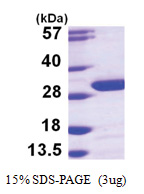UCHL3 (1-230, His-tag) Human Protein
Other products for "UCHL3"
Specifications
| Product Data | |
| Species | Human |
| Expression Host | E. coli |
| Expression cDNA Clone or AA Sequence |
MGSSHHHHHH SSGLVPRGSH MEGQRWLPLE ANPEVTNQFL KQLGLHPNWQ FVDVYGMDPE LLSMVPRPVC AVLLLFPITE KYEVFRTEEE EKIKSQGQDV TSSVYFMKQT ISNACGTIGL IHAIANNKDK MHFESGSTLK KFLEESVSMS PEERARYLEN YDAIRVTHET SAHEGQTEAP SIDEKVDLHF IALVHVDGHL YELDGRKPFP INHGETSDET LLEDAIEVCK KFMERDPDEL RFNAIALSAA
|
| Tag | His-tag |
| Predicted MW | 28.3 kDa |
| Concentration | lot specific |
| Purity | >95% |
| Presentation | Purified |
| Buffer | Presentation State: Purified State: Liquid purified protein Buffer System: 20 mM Tris-HCl buffer (pH 8.0) containing 1 mM DTT, 10% glycerol |
| Bioactivity | Specific: >3,000 pmole/min/ug. Measured by the hydrolysis of Ubiquitin-AMC at pH 8.0, at 37°C |
| Preparation | Liquid purified protein |
| Applications | Protocol: Activity Assay 1. Prepare a 100 ul of recombinant UCHL3 protein with various concentrations (0.48ng, 0.9ng) in assay buffer and equilibrate to 37°C for 10 minutes. (Assay buffer: 50mM Tris-HCl, 0.5 mM EDTA, 1 mM DTT, 0.1 mg/ml Ovalbumin, pH 8.0.) 2. Add 50 ul of 1uM Ubiquitin-AMC. 3. Read at excitation wavelengths 355nm and emission 460nm for 5 minutes. - Ubiquitin-AMC (Enzo, Cat.No, BML-SE211) - 96 Well Polystyrene Microplate, black (greiner bio-one, Cat.No, 655077) - Fluorescent plate reader (PerkinElmer, VICTOR X3) |
| Protein Description | Recombinant human UCHL3, fused to His-tag at N-terminus, was expressed in E.coli and purified by using conventional chromatography techniques. |
| Storage | Store undiluted at 2-8°C for up to two weeks or (in aliquots) at -20°C or -70°C for longer. Avoid repeated freezing and thawing. |
| Stability | Shelf life: one year from despatch. |
| Reference Data | |
| RefSeq | NP_001257881 |
| Locus ID | 7347 |
| UniProt ID | P15374, A0A087WTB8 |
| Cytogenetics | 13q22.2 |
| Synonyms | UCH-L3 |
| Summary | The protein encoded by this gene is a member of the deubiquitinating enzyme family. Members of this family are proteases that catalyze the removal of ubiquitin from polypeptides and are divided into five classes, depending on the mechanism of catalysis. This protein may hydrolyze the ubiquitinyl-N-epsilon amide bond of ubiquitinated proteins to regenerate ubiquitin for another catalytic cycle. Alternative splicing results in multiple transcript variants that encode different protein isoforms. [provided by RefSeq, Aug 2012] |
| Protein Families | Druggable Genome, Protease |
Documents
| FAQs |
| SDS |
Resources
Recombinant Protein Resources |
{0} Product Review(s)
0 Product Review(s)
Submit review
Be the first one to submit a review
Product Citations
*Delivery time may vary from web posted schedule. Occasional delays may occur due to unforeseen
complexities in the preparation of your product. International customers may expect an additional 1-2 weeks
in shipping.






























































































































































































































































 Germany
Germany
 Japan
Japan
 United Kingdom
United Kingdom
 China
China
